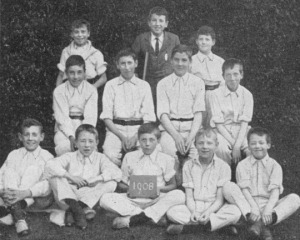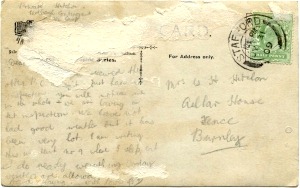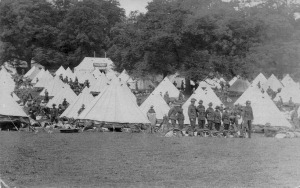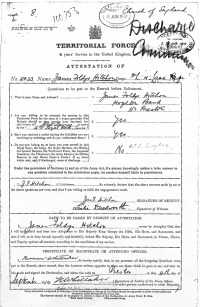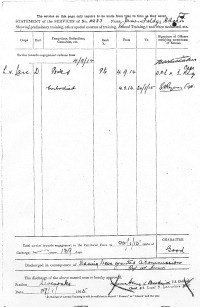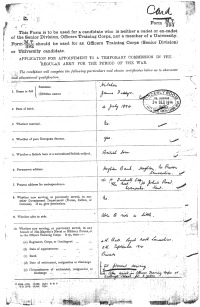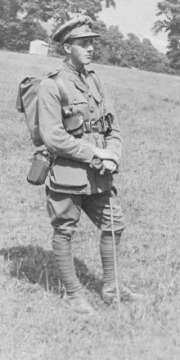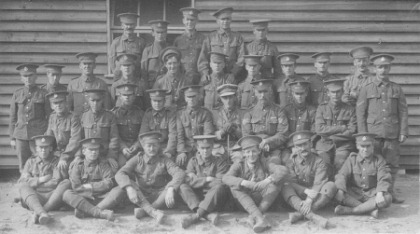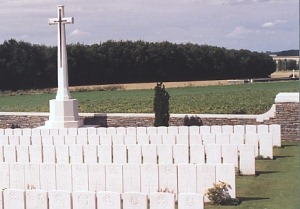
James Foldys Hitchon was born to George Henry Hitchon and Margaret Hitchon at Burnley on 4th July 1894. The 1901 Census shows the family to be living at Pendlehurst in Habergham Eaves, Burnley. James' father was a land surveyor and valuer at the time, and the family could afford to employ a domestic servant as well as a nurse to help look after James and his sisters Susannah Margaret (born 1895) and Eleanor Mary (born 1898). A younger brother, Lawrence Foldys, was born in 1905.
The Preparatory School magazine, "PATS", commented in 1917: J.F. Hitchon come to us in May, 1904. He was a boy of a quiet and amiable disposition and got on well with everyone; though not brilliant at work or play he was absolutely straight and trustworthy. He was good at music, and with his fidus Achates, H.C. Davies, he performed excellently in 'The King and Lazilee' in 1907. He got into our Football XI in 1907, and in 1908 his team won the Yard Sixes. He was in our Cricket XI in the same year when again he and his friend distinguished themselves in 'The Quest of the Golden Boy'. James remained at Sedbergh only until July 1910 when he left to train as an architect. While at the school, he served for two years in the Officer Training Corps. A postcard sent by James to his mother on 31st July 1909 while in O.T.C. Camp at Stafford has been kept by his family.
By 1914, the Hitchon family had moved from Fence to Hoghton Bank in Hoghton. On 4th September 1914 - one month to the day after war had been declared against Germany - James enlisted at Preston into the ranks of the The Loyal North Lancashire Regiment. He was described as being 5ft 6½in tall with good vision and good physical development. After serving little more than two months as a Private (No.2233) in the regiment's 4th Battalion, James applied for an infantry commission. With the strong support of his battalion's commanding officer, Lt.-Col. Henry Beckwith, James was duly granted his commission and on 20th January 1915 was appointed to the 10th (Reserve) Battalion, East Lancashire Regiment with the rank of 2nd Lieutenant.
James served with the 10th East Lancs at Teignmouth, Swanage and Wareham, receiving his promotion to full Lieutenant on 27th October 1915.
In June 1916, the 11th East Lancs (Accrington Pals) were short of officers as the battalion prepared to take part in the opening phase of the Somme offensive; Capt. Philip Broadley and Lt. Harry Bury had returned to England while Lt. Jack Ruttle was hospitalized with pneumonia. Replacements were urgently needed and, on 17th June, just 12 days before the attack was due to go in1, four young officers from the 10th Battalion reported for duty; one of the four was James Hitchon.2 James was assigned to Y Company, popularly known as the Chorley Pals, and went into the front line for the first time just two days later. Percy Allsup's diary records Y Company's tour of the trenches:
For the attack on Serre of 1st July 1916, James led one of eight platoons from Y and Z Companies that formed the 3rd and 4th waves of the battalion's attack. At 7.29am the two waves left their assembly trenches and advanced into the storm of battle, crossing the British front line around 6 minutes later. Watching them from his post at the bomb dump was Z Company's Fred Sayer. The tempo of the high velocity guns increased and suddenly there appeared hundreds of men from the rear trenches approaching us. It was Zero. "Z" Company were coming over as if on a parade, with bayonets fixed, but with rifles carried at the trail. Some passed our post into No Man's Land but none came within 50 yards or so. (Extract from "Solidus", the unpublished autobiography of Fred Sayer, by kind permission of Judy Langton.) Shortly after crossing into No Man's Land, James was hit. Two eye-witnesses were later found while they were recovering from wounds in hospital. Pte. James Scot Dalgleish - possibly James' orderly - had seen him fall into a shell-hole after being shot in the abdomen. Pte. Felix Rawcliff said that he had been with James' orderly in No Man's Land, and confirmed that James had been wounded; under heavy enemy fire, the two men were unable to bring James back into the British lines. At James' home in Hoghton Bank, the family was informed by the War Office only that he was missing. His aunt, Mary Hargreaves, wrote to the War Office to ask for news of him; her letter remains filed with his service papers to this day. In September 1917, "Wasp", the magazine of Evans House at Sedbergh School, published the following tribute.
James Foldys Hitchon is also commemorated on the Brindle War Memorial in St. James' Church, Brindle and on the memorial at Holy Trinity Church, Hoghton.
© Andrew C Jackson 2003 My thanks go to Steve Williams of the Brindle Historical Society who researched much of this article, and to Howard Richard Hitchon, Mr. R. Gladstone, Miss. M. Gladstone and Elspeth Griffiths (Archivist and School Librarian, Sedbergh School) for kindly allowing me to publish photographs and other material from their collections. Other source material included the 1901 Census and TNA document WO339/34554.
|
